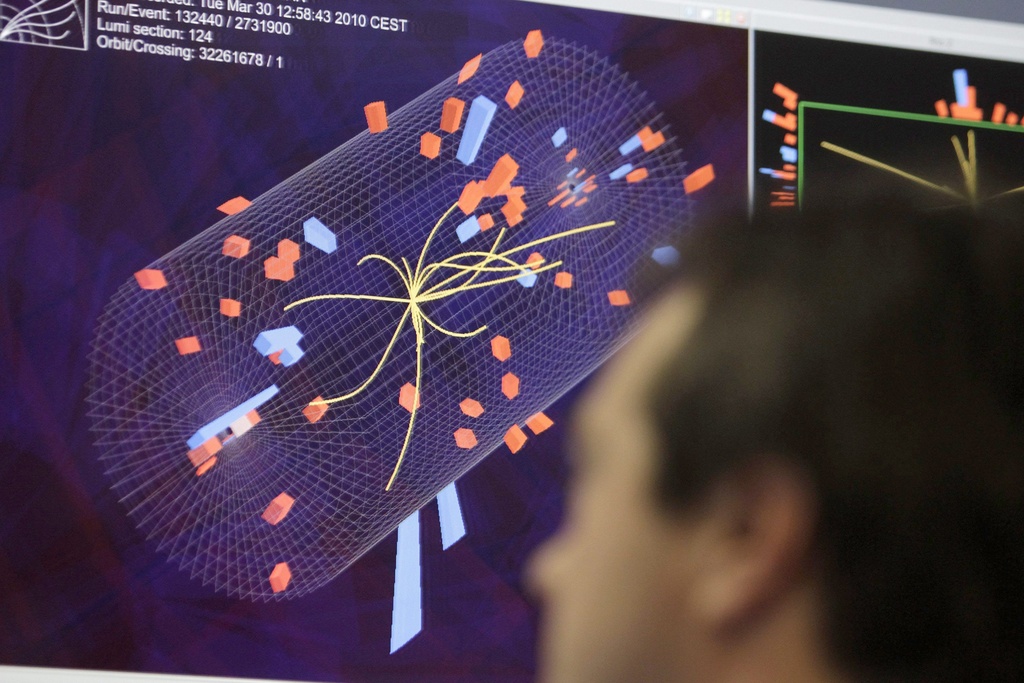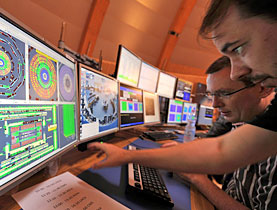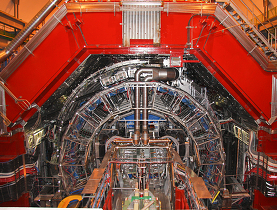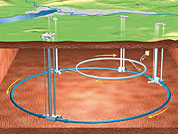Cern takes step to unlocking secrets of universe

Scientists using the “Big Bang” machine deep in the ground near Geneva have successfully smashed proton beams together infused with record-breaking energy levels.
Researchers from the European Organization for Nuclear Research (Cern) say the world’s biggest atom smasher may generate its first scientific breakthroughs later this year when they hope it can unlock secrets of modern physics such as dark matter.
Tension was palpable early on Tuesday morning in the main Cern control room as two technical problems with the proton beams fired at close to the speed of light around the 27-kilometre tunnel 100 metres beneath the Swiss-French border delayed the experiment.
But these hiccups were soon forgotten as the energy of the two proton beams was again slowly ramped up to a record-breaking seven trillion electron volts (TeV) – three times the earlier record set in November.
Then at 12.58pm the beams whizzing 11,000 times a second in opposite directions around the Large Hadron Collider (LHC) were smashed together in four bus-sized detector chambers.
The complex, landmark experiment, which was described as being akin to “firing needles across the Atlantic and getting them to collide half way”, was met with loud applause and champagne by the emotional scientists.
“It took us a few attempts, but I think it worked out beautifully,” Vivek Sharma, a physics professor from California University, told swissinfo.ch. “This is a very special moment. It’s taken us 25 years to build; this is what it’s for. Finally the baby is delivered. Now it has to grow.”
The collisions, the high point of the SFr10 billion ($9.4 billion) experiment, which will continue for years, were hailed as a real Star Trek moment.
“We are going into new territory where no man has gone before,” said Jean-Pierre Revol, senior analyst for heavy ion collisions at the Alice experiment detector. “Today is an important step.”
“It just shows what we can do in pushing knowledge forward on where we came from, how the early universe evolved,” echoed Cern director-general Rolf Heuer.
“Step into the unknown”
The multiple underground collisions each created mini Big Bangs, producing data to be analysed by thousands of scientists at Cern and in laboratories around the world linked by a computer network known as the Grid.
By crashing such high-energy beams of protons into each other, the scientists hope to gain key insights into the make-up of matter and the creation of the universe billions of years ago in the moments after the Big Bang.
“This is a step into the unknown. We are doing something that no one has done before. We hope we find things that are really new,” said Cern research director Sergio Bertolucci. “There are known unknowns out there, like dark matter and new dimensions about which we hope to learn. But it is possible that we will find some unknown unknowns which could be hugely important for mankind. With the LHC, we have the tool that we need.”
Astronomers and physicists say that only five per cent of the universe is currently known, and that the invisible remainder consists of dark matter and dark energy, which make up some 25 per cent and 75 per cent respectively.
Another widely publicised aim of the LHC is to try to find the elusive theoretical particle – the Higgs boson – that gave mass to matter that emerged after the primeval explosion 13.7 billion years ago.
But scientists say the data gathered will take time to analyse, and the public should not expect the first interesting results before the end of 2011 at the earliest.
“Major discoveries will happen only when we are able to collect billions of events and identify among them the very rare events that could present a new state of matter or new particles,” said Guido Tonelli, a spokesman for the CMS detector at the LHC.
Staying focused
The LHC was launched with great fanfare on September 10, 2008, but broke down nine days later when a badly soldered electrical splice overheated, causing extensive damage to the massive magnets and other parts of the collider deep underground.
It cost $40 million to repair and improve the machine so that it could be used again at the end of November.
Since then the collider has performed almost flawlessly, giving scientists valuable data in the four-week run before Christmas. It quickly eclipsed the next largest accelerator, the Tevatron at Fermilab near Chicago.
The plan is to now run the LHC continuously at 7 Tev for 18-24 months while steadily increasing the proton density in each beam until the end of 2011. It will then be shut down for a year of maintenance and upgrading to prepare it for years of experiments at full power – 14 TeV.
Simon Bradley in Geneva, swissinfo.ch
In the LHC, high-energy protons in two counter-rotating beams are smashed together to search for exotic particles.
The beams contain billions of protons. Travelling just under the speed of light, they are guided by thousands of superconducting magnets.
The beams usually move through two vacuum pipes, but at four points they collide in the hearts of the main experiments, known by their acronyms: ALICE, ATLAS, CMS, and LHCb.
When operational, the detectors see up to 600 million collision events per second, with the experiments scouring the data for signs of extremely rare events such as the creation of the so-called God particle, the yet-to-be-discovered Higgs boson.

In compliance with the JTI standards
More: SWI swissinfo.ch certified by the Journalism Trust Initiative




You can find an overview of ongoing debates with our journalists here. Please join us!
If you want to start a conversation about a topic raised in this article or want to report factual errors, email us at english@swissinfo.ch.